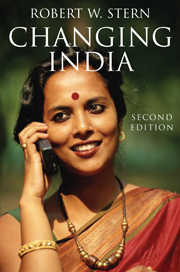Book contents
- Frontmatter
- Contents
- List of maps and tables
- Preface to the second edition
- Glossary
- Introduction: Change, the societies of India and Indian society
- Part I The changing countryside
- Part II Change from above
- Appendix One Major political events in the related histories of British imperialism and Indian nationalism, 1858–1947
- Appendix Two Major political events in the history of the Indian Union, 1947–2002
- Notes
- Guide to further reading
- Index
Preface to the second edition
Published online by Cambridge University Press: 18 April 2011
- Frontmatter
- Contents
- List of maps and tables
- Preface to the second edition
- Glossary
- Introduction: Change, the societies of India and Indian society
- Part I The changing countryside
- Part II Change from above
- Appendix One Major political events in the related histories of British imperialism and Indian nationalism, 1858–1947
- Appendix Two Major political events in the history of the Indian Union, 1947–2002
- Notes
- Guide to further reading
- Index
Summary
I posted the manuscript of Changing India's original edition to Cambridge in early 1992, some months before December when Hindu militants wrecked the Babri Masjid in Ayodhya. It was a major event in modern Indian history. And there have been others. The advent in New Delhi of a “Hindu nationalist” Bharatiya Janta Party-led government in 1998 was one, certainly. The ongoing liberalization of the Indian economy had just begun in 1992. As had the climb to power of the Other Backward Classes that nowadays dominate Indian politics. The “Kargil War” of 1999 was a major event in India's international relations, and not only with Pakistan; as was America's “war on terrorism” in Afghanistan and the attack by jihadis on the Indian parliament in 2001.
In this second edition of Changing India I have tried to share with readers new to South Asian studies and colleagues immersed in them my observations of these and other changes over the past decade: not only in India, but in the ways in which I've come to understand it. To that end, I've done some signposting with phrases such as “since 1992,” “over the past decade,” and so forth. To fit it all in, I've had to edit some of my discussion of changes that took place before 1992. In some cases this wasn't at all difficult, and in others it was salutary. Hindsight gives us some perspective on the past.
- Type
- Chapter
- Information
- Changing IndiaBourgeois Revolution on the Subcontinent, pp. xii - xiiiPublisher: Cambridge University PressPrint publication year: 2003



